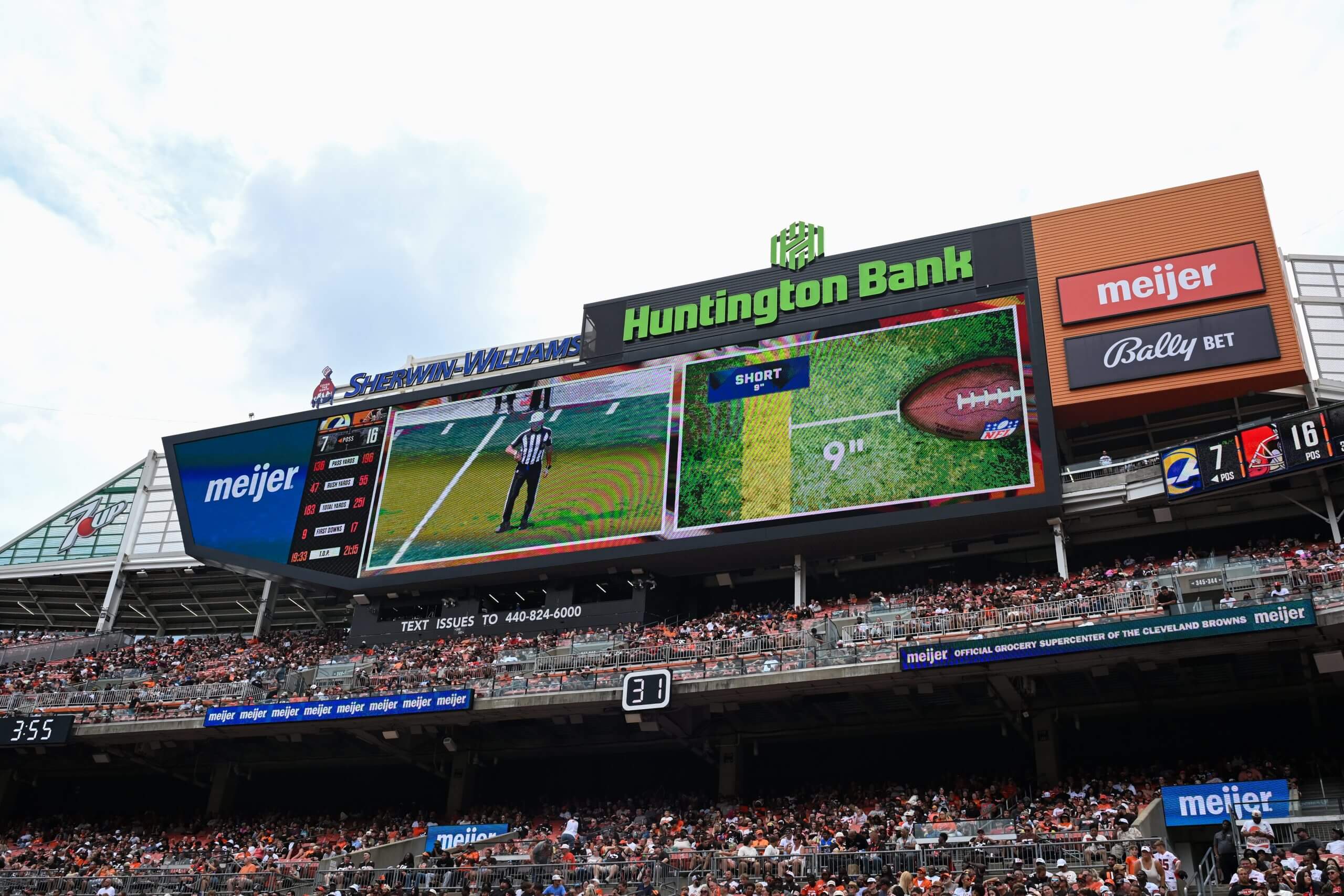With the Denver Broncos leading the Tennessee Titans 20-12 late in their Week 1 matchup, Denver quarterback Bo Nix tried a sneak on fourth-and-1. He was quickly brought down by Tennessee tackle T’Vondre Sweat, and instead of the chain crew running out to measure the first down, the NFL’s new virtual measurement system got its first in-season rep.
In a partnership with Sony’s Hawk-Eye, which also provides technology for coaches’ headsets and replay services, the NFL’s primary measurement of first downs is now done virtually. Six 8K cameras have been installed along one side of each NFL stadium to optically track the ball’s position, and in Week 1, measured Nix 10 inches short of a first down.
Humans aren’t completely absent from the process. A virtual measurement sets off a domino effect traced back to operators at the league’s central officiating center in New York, who process and confirm the measurement before sending the virtual verdict to game officials, announcers and viewers, similar to how replay review works.
The measurement system was tested at all NFL stadiums last year, with Sony’s Hawk-Eye and the NFL working to ensure consistency across stadium infrastructures and weather conditions. Two games last year tested the latter: one with heavy fog and another with mounting snow.
“Cameras can’t track what they can’t see,” said Justin Goltz, commercial director for Sony’s Hawk-Eye North America. “I think that’s always going to be the risk or the con of an optical tracking system.”
The concern of visual impairment actually has more to do with the camera lens than the physical covering of the field. Fields themselves are virtually calibrated, meaning the cameras can determine the ball’s location even if the yard markers are covered by snow. The main issue is when the snowfall begins to cover the camera lens.
“Our cameras were occluded by the snowfall itself, not necessarily the snow on the ground,” Goltz said. “That’s a real-world situation that I think all parties are aware of. And we have disaster recovery protocols and backup plans in place to mitigate that if necessary.”
Instances like those are why the NFL is keeping the chain crew around in a secondary capacity. Rama Ravindranathan, vice president of IT for the NFL, said the chain crew will come out for “any unforeseen scenario,” including weather or connectivity issues.
At international venues, where the technology isn’t present year-round, the league installs the Sony Hawk-Eye cameras two or three days before the game, Goltz said.
One criticism of virtual measurement is that it doesn’t address perhaps the larger issue with first-down measurement: spotting the ball, which caused frustration during a fourth-quarter virtual measurement in the Week 2 Chiefs-Eagles matchup on a Philadelphia tush push play. On-field referees are still responsible for the initial spot, just like they were with the chain crew. Virtual measurement steps in after to determine the distance between the spotted ball and the line to gain.
While Sony’s Hawk-Eye technology can do a good job of measuring first downs, it can’t help with the trickier aspect of spotting the ball. (Nick Cammett / Getty Images)
Goltz learned last year that education around virtual measurement was important. Rumors of lasers or tracking chips in the balls are inaccurate — at least when it comes to virtual measurement.
There are chips in balls, installed by the NFL and Next Gen Stats, to measure things like speed, acceleration and distance. However, these chips don’t impact ball spotting.
“We are having conversations with the NFL on what the future of this technology could look like to potentially aid with the precursor steps to measurement,” Goltz said of potential improvements to the technology. “Ball spotting is a very difficult problem to solve, but the NFL is working in a direction where I think they’ve got a lot of cool tools at their disposal.
“It is a topic of conversation to see if we can help with those precursor steps in the future.”
The goals of virtual measurement focus on accuracy and efficiency. The process is supposed to take around 30 seconds, saving up to 40 seconds from a manual measurement with the chains.
That timetable was criticized for some delays in preseason games, such as in the New England Patriots-New York Giants matchup. Players stood on both sides of the ball, awkwardly awaiting the decision, while play-by-play announcer Al Michaels commented on the slow pace. Awaiting the virtual result felt like a slightly less dramatic process than watching each end of the 10-yard chain planted on the field before a referee signaled the result.
However, Ravindranathan said feedback since the regular-season implementation has been positive.
“The goal for how this came about was that we wanted to make the game faster and more efficient,” Ravindranathan said. “In that context, I think there was definitely positive feedback that we had received from the coaches.”
Goltz said coaches have had a significant input in the rollout, especially in the visualization that specifies the distance between the ball and the line to gain.
“They need to understand and be able to comprehend what the measurement was, whether it was short or long, so that they can make their next play call and strategize the game plan accordingly,” Goltz said. “It was cool to me and maybe an oversight that (coaches) would have input on the process and the graphic representation because their job is affected by it as well.”
(Top photo of a virtual measurement at a preseason game between the Jets and Giants: Rich Barnes / Imagn Images)


